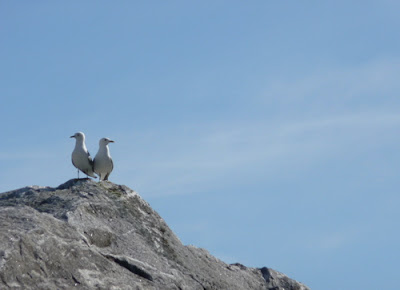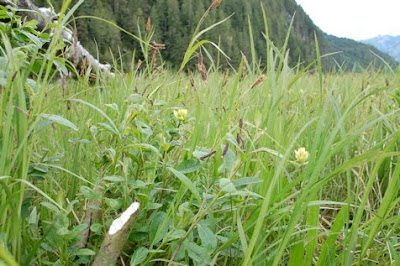
For years we have been trying to sail into the Kitlope. This year on our way north we did.
Next to Haida Gwaii, protection of the Kitlope has been the most important good news story for First Nations people and environmentalists. It is the setting for Monkey Beach, a wonderful novel by Enid Robinson, native of Kitamaat. And we have heard so many stories of its awesome beauty and remoteness.
Doug soaks in warmth and beauty
Hot pools over the ocean
Although the Europa hot springs are probably the most famous on the north coast, very few actually visit them. This whole area is quite out of the way. Remote.
Mountains to sea
Sailboat dwarfed
Hanging blue glacier
sunset on mountaintops

So we dinghy-ed over to get some snow
for delicious snow cones aboard.
This trip was a delight for us. We remarked often of our sense of peace and connection to nature, beauty and wholeness. We enjoyed each others' company in work, play and solitude.
One of the reasons for our blissful experience was the absence of logging scars. The Kitlope Valley is the world's largest undisturbed coastal temperate rainforest. In 1994, 317,000 hectares were set aside to protect the area. The Haisla people were responsible for the research, planning and lobbying that brought about this decision. The work goes on, to continue protection of this priceless treasure.
We enjoyed wonderful wildlife and the local food.
Grizzly in Owyacumish Bay
Well-fed black bear eating sedges in Chief Matthews Bay.
Barn swallows have a rest on La Sonrisa
seagull pair
The nest with egg they are watching
Beaver’s work - Kitlope River estuary
Lucky for us, crab and prawns are Dougs favourite foods!
This almost 9" crab has Doug's name on it.
Crab lunch stop
Spot prawns above, coon stripe shrimp below
Shrimp sandwich
This is the site of the shore facilities for the Kemano Power Station, a major engineering feat, but environmentally questionable. The Nechako River and major lakes were dammed and tunneled through the Coast Range mountains to drive pelton wheel power generators deep inside the mountain.
Here is the site in it's setting in Kemano Bay.
In the early 1990's, when word got out about planned expansion of this project, public opposition mounted until the provincial government withheld approval and work was stopped.
Here is what you first see as you approach Kemano Bay.
The beauty and peace of the area includes a very light human presence. The First Nations sites show the respectful presence of the Haisla people on their land.
First Nations watch cabin in the green waters by Europa hot springs
Owyacumish Bay cabin. A large grizzly was at home here.
First Nations summer salmon camp on peninsula in Kemano Bay
Abalone eyes - pole guarding First Nations site at head of the sacred Kitlope waters
Kawesas lodge - Kitlope River estuary
After we left the Kitlope we discovered that there had been a major feast on May 29. The Solidarity Gathering of Nations was hosted by the Haisla and Gitga'at Nations in Kitamaat Village. A friend who attended found it to be "the most generous, gracious feast I ever attended." Wonderful traditional foods, music and drumming. All coastal nations were present and re-affirmed the commitment to stop the Enbridge Northern Gateway Pipeline.
Here are links to find out more:
http://s2sca.blogspot.com/2010/05/feast-hosted-by-haisla-gitgaat-at.html
http://dogwoodinitiative.org/blog/coastal-first-nations-declare-ban-on-tankers































